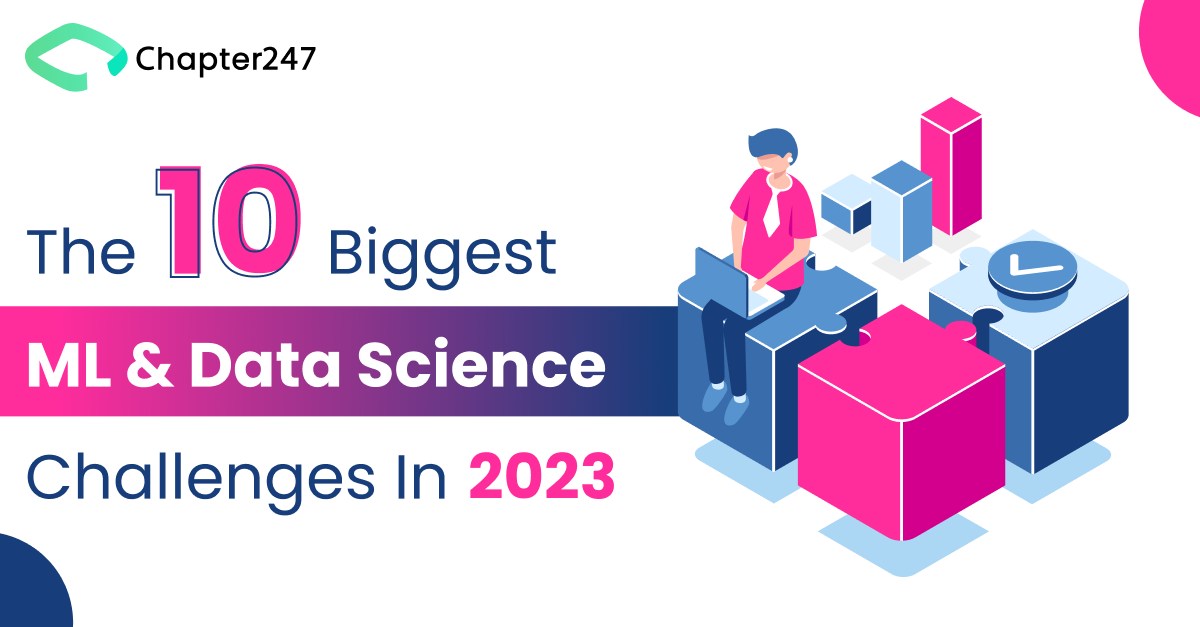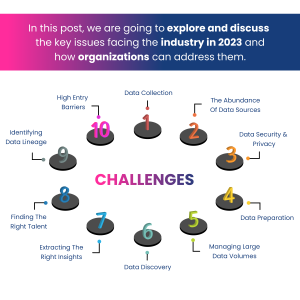Big data technology is evolving so quickly that it’s creating an innovation boom in emerging tech. New applications, like AI and ML, have benefitted immensely. While it is great, it may be difficult for organizations to keep up with the changing pace. Indeed, in this modern world data is the lifeblood of any business and is an integral part of all decision-making processes. But collecting and using this data can be challenging if you’re not up to date with the latest tools.
In this post, we are going to explore and discuss the key issues facing the industry in 2023 and how organizations can address them.
ML and Data Science Challenges
1. Data collection
The first problem is that organizations collect big data without deciding whether it’s useful or not. This has been driven by a general fear of missing out on key insights that could be gained from it, and the widespread use of hypothesis-driven research in a variety of fields makes it likely that such data will never be cleaned. Sadly, most of the data generated just causes more problems, instead of solving them.
2. The abundance of data sources
Companies have always been gathering data about their customers, sales, and more but now they’re doing it more often & with more focus on the customer experience and values. They do this with a variety of tools and software. Data coming from different sources can cause some issues when it comes to management and consolidating data, but with the right resources, like an AI writer, it’s not too hard to find the solution for your needs.
As organizations try to find all the data they can by using what’s available, there will always be more sources to consolidate and assess. This creates meaningful decisions for the data scientist. When it comes to getting information from different sources, the more variety you have, the more complicated things can become.
3. Data security and privacy
One of the obstacles to gathering data for analysis is finding the right sources. However, this is mitigated by growing privacy concerns and compliance requirements restricting access. Not only can these AI writing assistants save time & effort, but their adoption also means that cyberattacks are more prevalent in recent years. They often come in the form of phishing emails targeted at executives and employees. Data scientists and ML teams find it a lot harder to access the data they need. This is largely due to tightened security & regulatory requirements.
4. Data preparation
Data preparation is laborious and complicated, often seen as the most difficult part of building a machine learning model. However, it’s an essential step to ensuring ML models are based on high-quality data. As a result, you’ll create an even stronger model that’s more accurate. Luckily, there are a lot of tools available on the market now that can help data scientists pre-process their data. This saves them loads of time which they can use to focus on developing models.
5. Managing large data volumes
As we’ve already said, the amount of data that’s available is increasing at a rapid time. According to the IDC Digital Universe report, in 2012 alone, an estimated 2.8 trillion gigabytes of data was processed and to think just five years ago it was 1.9 trillion gigabytes! It shouldn’t come as a surprise then that managing this huge amount of data can be difficult for organizations. Especially because most of this data is unstructured and not organized into a traditional database system.
6. Data discovery
You would have thought that by this time, data and ML teams would have been well on their way to building powerful ML models right? Well, not always the case. There’s still more work to be done and ML teams will often have questions like, It’s not clear how many values are missing. X or Y column name? Who can I ask about…? etc. While these questions might sound straightforward, finding the right person who can answer them is not always easy. In many organizations, datasets are not fully owned or documented and you don’t even know how to ask for that type of information.
7. Extracting the right insights
A lot of people believe there’s no point in cleaning and organizing data if it’s going to be left unused. It makes more sense to just process, store, and extract the data you need in order to achieve your goals. The only way this can be done is by cleaning up your data so that you have a better understanding of what it contains.
However, when organizations wish to extract insights they want them quickly. To speed this up they are turning to new generation analytics tools that can give out self service reports. These new tools have the capacity to reach way more people than a typical business intelligence tool.
8. Finding the right talent
There is a lot of demand for data science skills, but not many people have the knowledge needed. Companies often struggle to find the right people with the right level of expertise for their machine learning teams.
In addition to finding people with domain expertise, companies are looking for a breadth of skills in data science, which includes both the right business thinking. For example, integrating machine learning into your business is hard if you don’t have the know-how on how to do so.
9. Identifying data lineage
Data lineage is the process of understanding, recording and visualizing all transformations data goes along the way to be consumed. It is basically a record of what changed and why in celebration of the recent success of your commercial enterprise. Just knowing where your data is from isn’t always enough. Data lineage can be really helpful in areas such as data migrations, governance, and strategic reliance on data.
10. High entry barriers
It’s no secret that juggling your own machine learning team, managing your own projects and building and deploying your own machine learning tools is an expensive undertaking. The costs of any enterprise-level endeavor are always going to be rather expensive, especially when they’re not outputting the desired results. That’s why it can often take even large enterprises some time to come around to making any major business decision.
Outsourcing the big data/ ML engineering platform is often a better idea because it delivers better results and more importantly, you are relieved of the headaches that come with it.
Conclusion
The digitized world means that companies in the digital age must make fast decisions. Data science has made it necessary to develop a strategy that can mesh with your goals and needs.
While it may seem like getting involved with data and ML is too expensive for most small or mid-level organizations, this assumption is actually false. Although small businesses face significant hurdles when it comes to putting together their own AI teams, there are plenty of tools to help them overcome these barriers.
Some companies can overcome these challenges alone, but most turn to full-service platforms with data and ML engineering expertise. With Chapter247, for example, organizations that defer the expertise or infrastructure can easily unlock the true power of their data and get succeeded. So, get in touch with us and sort out your ML journey with our support.









